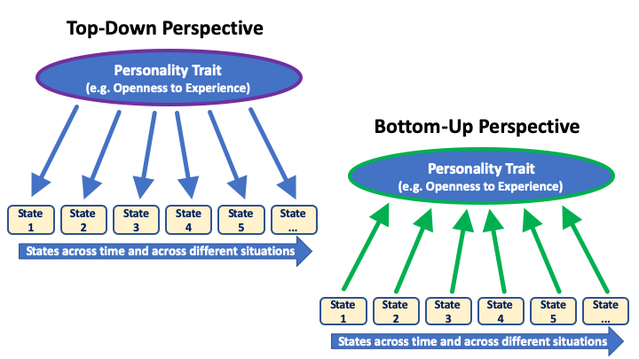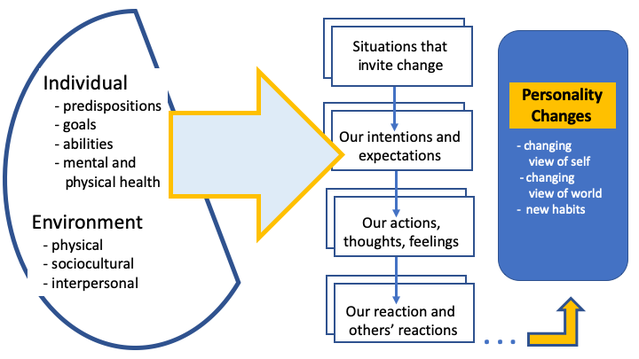Personality
Personality and Change – Is our Personality Really Fixed?
An ABCD approach to thinking about how we can change
by Wilma Koutstaal Ph.D.THE BASICS

Changing times evoke questions about change. What prompts us to change? How fixed, really, is our "personality"?
The way that we initially respond to these questions may be shaped by our views of personality itself. Do we see personality from a mostly top-down perspective? From a top-down perspective, we think of personality as someone's general predisposition to act and feel in certain ways, that then guides, filters, and funnels the types of situations and interactions ("states") they are likely to experience.
Or do we, instead, think of personality in a largely bottom-up way? From a bottom-up perspective, we think of personality as the accumulated average of how someone tends to behave and feel across varied situations and interactions – a summary of the many experiential "states" they have transitioned through. We can think of personality from a top-down "encompassing" perspective (the trait summarizes and overarches many states) or from a bottom-up "emerging" perspective (the trait emerges from an accumulation of states).

But, what if neither the bottom-up nor the top-down perspective entirely captures what we mean by "personality" and so both can be true, to varying extents? Encountering day-to-day situations that invite us to change (e.g., changes in our life circumstances, unexpected obstacles or setbacks, new opportunities) may – depending on how often we encounter such situations, how we respond to them, and on our own and other's reactions – cumulatively lead to personality change. As pictured below, this is the iterative and more contextually-anchored perspective that is suggested by one recent Personality Change Model. Note how dynamic and iterative the change model is. Note, too, how it's not only our individual selves, such as our predispositions, goals, or abilities, but also our physical, sociocultural, and interpersonal environments that, together, can promote personality change.

What are we considering when we talk of "personality"?
Personality is, in part, about how we typically tend to behave – for example, whether we are most often talkative or are usually quiet, or whether we are likely to jump at the opportunity to explore new ideas and new ways of doing things or, instead, are more prone to stick to the tried-and-true approach we've used many times before.
But personality is not just about how we are likely to behave or to act. It is also about how we generally tend to feel, for example, are we usually upbeat, hopeful, and optimistic, or not, and how stable our feelings typically are, or how volatile. Personality is also about what we usually find pleasant, fun and rewarding (or not), and what motivates us, keeping us going and trying again and again.
One helpful way of thinking of the different dimensions that all contribute to personality, and what its components are, is what has been called the ABCD framework:
A = affect (what and how we feel, or emotion/mood)
B = behavior (what and how we act or do things)
C = cognition (what and how we think)
D = desire (what and how we want things; what we try to bring about, or to prevent)
So, what about changing our personality?
In the past several years, views about personality have themselves been changing. Rather than seeing personality as for the most part stable and constant, many researchers now take a more dynamic view of personality that emphasizes both continuity or constancy and change.
For example, across our lives, one factor contributing to changes in personality is alterations in our social roles and responsibilities. Indeed, many studies have found that, as individuals move from later adolescence into adulthood, their personality characteristics gradually become more adaptive and appropriate to their new situation such as new work responsibilities or new personal relationships. New roles bring with them different goals, and new ways of thinking and responding. If repeatedly experienced, these new ways of thinking and responding may become habitual or "trait-like" – as pictured in the Personality Change Model.
But what about other sorts of life-related events, such as engaging in a new type of training or intervention? Could these also significantly change someone's personality?
The answer seems to be yes. One recent large-scale summary of many different studies measured personality before and after various sorts of interventions. The systematic meta-analysis – including more than 200 studies, and more than 20,000 participants – showed that personality traits can, indeed, change after different types of change interventions, such as an 18-hour course helping undergraduates learn to better understand and deal with their own and others' emotions. The alterations in personality traits also appeared to be comparatively long-lasting – with changes still apparent after time periods of six months, and one or more years after the intervention.
So what personality characteristics changed? The largest and most consistently observed changes were found in emotional stability. Significant changes were also found for extraversion, agreeableness, conscientiousness, and blended combinations of traits. Changes in "openness to experience" – broadly encompassing one's tendency to flexibly explore novel ideas and experiences – were also observed, for some but not all of the different ways of assessing change.
By adopting a view of personality that is a mix of bottom-up and top-down processes, and as something that emerges over time, and with repeated experience, change may emerge if we change our environment or our goals and the many experiential "states" we cumulatively inhabit over time. By actually taking a first step into the desired new direction such as being more open or more conscientious – and then another step, and another, and another – new ways of thinking, acting, and feeling will be repeatedly experienced, and may become habitual or trait-like. We may indeed deeply change ourselves, and in a positive, lasting way.